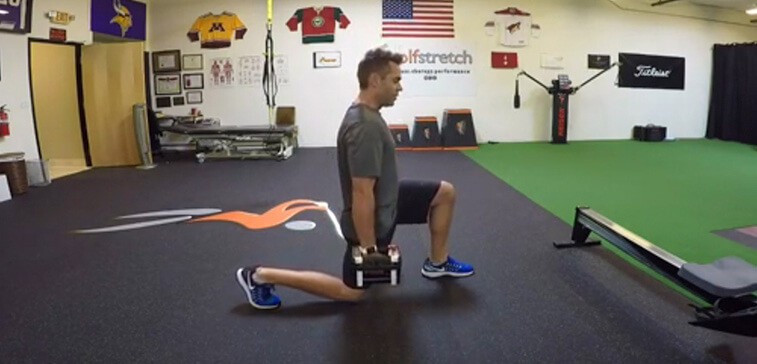
Blog Breakdown:
- For clients hoping to achieve a strong, powerful golf stance, there is no better way to accomplish this goal than exercising the quads and glutes.
- Three-way lunges are one of the best ways to strengthen the glutes and stretch out the quads because they hit three different contractions.
- In this blog, CEO of Golfstretch Adam Swanson demonstrates three different lunge exercises to help improve lower body strength.
In my opinion, obtaining lower body strength is just as important as gaining upper body strength in golf. Actually, if you want to get technical, I believe whole-body strength is imperative if you want to hit the ball farther, increase power in your golf swing, and reduce your risk of injury. Regardless, the lower body seems to get neglected by many physical therapists and certified golf fitness instructors because it doesn’t appear to be as important as conditioning the abdomen, shoulders, and arms. Having strong, powerful legs helps stabilize the core, which in turn, protects the lower back and hips from damage.
At Golfstretch, the name of the game is: “improve strength, enhance flexibility, boost mobility, increase power, and decrease your risk of injury.” That includes every muscle in the body – not specific muscles only used in golf. Today, I’ll be demonstrating a lower body exercise called “three-way lunges,” which helps strengthen the glutes and quads. If you want more powerful legs for golf, continue reading.
Before I explain how to perform these exercises, I want to discuss why they’re in important in golf. Many people starting out in golf learn to keep their legs shoulder-width apart when taking a shot. This may be helpful for some shots, but other shots that require more power (think: a drive) often need a wider stance to fully activate and engage the leg muscles, hips, and core. A wider stance also allows for greater hip internal and external rotation. Nevertheless, it’s clear the legs play an important part in each golf swing, so it’s crucial we include them in our golf fitness programs.
This three-way lunge exercise is perfect for strengthening the lower body because it hits three different muscle contractions in the glutes and quads: full contraction, short contraction, and deep contraction. Each one of these contractions is vital for improving muscle memory, stretching out the muscles, and generating force in the muscles for more power.
Full Contraction
For this first lunge, you can use your body weight or hand weights for a bit of a challenge. As you can see in my video, I perform a normal lunge with my left foot in front of me, and my right foot behind me. When I lower down, both legs create a 90-degree angle. This should occur during each lunge to prevent injury. For a full contraction, lower down until your knee gently taps the floor. You should not be resting your knee on the floor. Then, come back up and perform this exercise 9 more times for a total of 10 reps.
Short Contraction
For a short contraction, lunge as you normally would, but instead of lowering all the way down, bend your knees so you’re only going down a few inches. Make short movements while engaging your leg muscles. You should feel this after 10 reps.
Deep Contraction
Finally, a deep contraction requires lowering down right before your knee touches the floor and making small contracting movements to strengthen the quads and glutes. Complete 10 reps of this exercise before restarting the circuit. If you really want to feel a burn, repeat this circuit 3-4 times.
Check out the video below and let me know what you think of these lunges!
Golfstretch is a sports performance and rehabilitation center located in Scottsdale, Arizona. Utilizing a combination of therapies, the team at Golfstretch helps clients achieve their health and fitness goals. To learn more about golf fitness, stretch therapy, corrective exercise, and more, call 480-269-1119 to schedule a consultation today! We look forward to hearing from you!
The advice and information contained in this article is for educational purposes only and is not intended to replace or counter a physician’s advice or judgment. Please always consult your physician before taking any advice learned here or in any other educational medical material.
